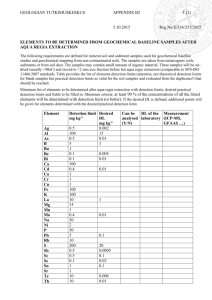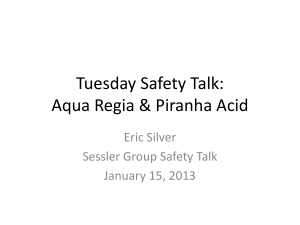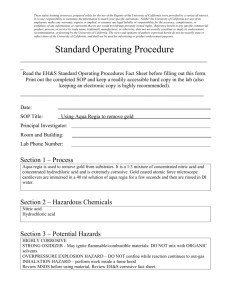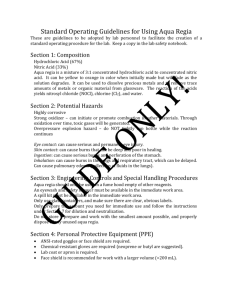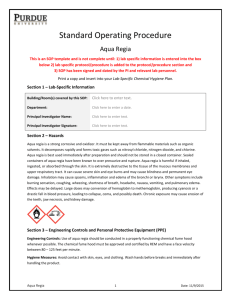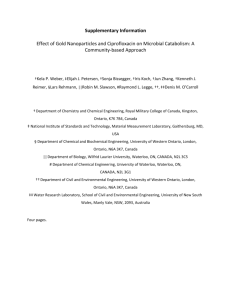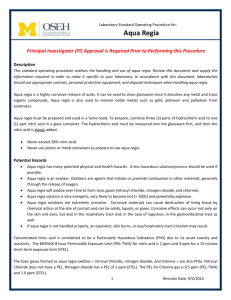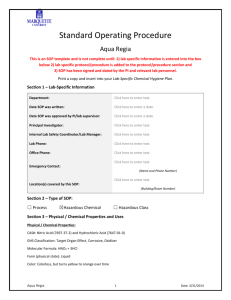Aqua Regia
advertisement
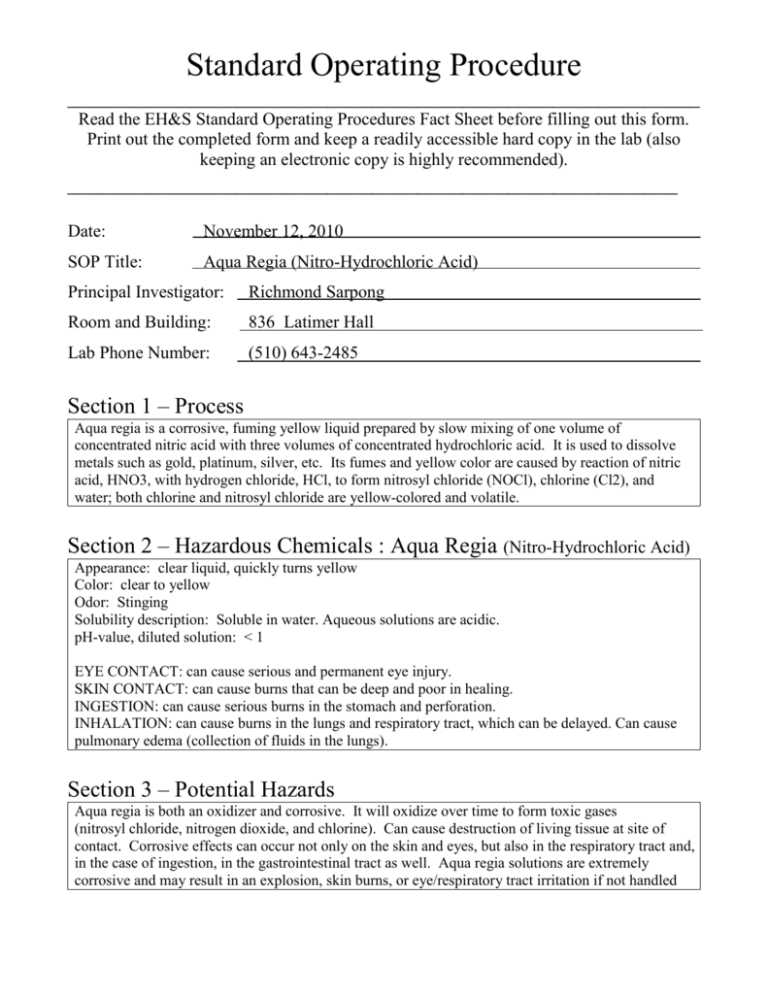
Standard Operating Procedure ________________________________________________________ Read the EH&S Standard Operating Procedures Fact Sheet before filling out this form. Print out the completed form and keep a readily accessible hard copy in the lab (also keeping an electronic copy is highly recommended). ______________________________________________________ Date: November 12, 2010 SOP Title: Aqua Regia (Nitro-Hydrochloric Acid) Principal Investigator: Richmond Sarpong Room and Building: 836 Latimer Hall Lab Phone Number: (510) 643-2485 Section 1 – Process Aqua regia is a corrosive, fuming yellow liquid prepared by slow mixing of one volume of concentrated nitric acid with three volumes of concentrated hydrochloric acid. It is used to dissolve metals such as gold, platinum, silver, etc. Its fumes and yellow color are caused by reaction of nitric acid, HNO3, with hydrogen chloride, HCl, to form nitrosyl chloride (NOCl), chlorine (Cl2), and water; both chlorine and nitrosyl chloride are yellow-colored and volatile. Section 2 – Hazardous Chemicals : Aqua Regia (Nitro-Hydrochloric Acid) Appearance: clear liquid, quickly turns yellow Color: clear to yellow Odor: Stinging Solubility description: Soluble in water. Aqueous solutions are acidic. pH-value, diluted solution: < 1 EYE CONTACT: can cause serious and permanent eye injury. SKIN CONTACT: can cause burns that can be deep and poor in healing. INGESTION: can cause serious burns in the stomach and perforation. INHALATION: can cause burns in the lungs and respiratory tract, which can be delayed. Can cause pulmonary edema (collection of fluids in the lungs). Section 3 – Potential Hazards Aqua regia is both an oxidizer and corrosive. It will oxidize over time to form toxic gases (nitrosyl chloride, nitrogen dioxide, and chlorine). Can cause destruction of living tissue at site of contact. Corrosive effects can occur not only on the skin and eyes, but also in the respiratory tract and, in the case of ingestion, in the gastrointestinal tract as well. Aqua regia solutions are extremely corrosive and may result in an explosion, skin burns, or eye/respiratory tract irritation if not handled properly. Section 4 – Approvals Required Use of aqua regia reagents requires training and the approval of the appropriate lab member. Section 5 – Designated Area Aqua regia should only be used in the fume hood. Section 6 – Special Handling Procedures and Storage Requirements Only prepare the amount you need for immediate use and follow the instructions (under section 7) for dilution and neutralization of unused solution Work with the smallest practicable amount of Aqua Regia needed to perform your task Never put Aqua Regia in a closed vessel; evolved gases will cause a pressure build-up and possible explosion Never take Aqua Regia out of the fume hood First Aid measures: Inhalation Move the exposed person to fresh air at once. Perform artificial respiration if breathing has stopped. Keep the affected person warm and at rest. Get prompt medical attention. When unconscious, loosen tight clothing and position in secured recovery position. Ingestion NEVER MAKE AN UNCONSCIOUS PERSON VOMIT OR DRINK FLUIDS! Promptly get affected personnel to drink large volumes of water to dilute the swallowed chemical. DO NOT induce vomiting. Get medical attention immediately. Skin Wash off promptly and flush contaminated skin with water. Promptly remove clothing if soaked through and flush skin with water. Get medical attention if irritation persists after washing. Eyes Promptly wash eyes with plenty of water while lifting the eye lids. Continue to rinse for at least 15 minutes and get medical attention. Section 7 – Personal Protective Equipment Goggles, lab coat, chemical-resistant gloves (18 mil neoprene, Silver Shield, or any other glove rated to protect against hydrochloric AND nitric acid) Face shield and acid-resistant apron are recommended if working with a larger volume (>200ml) Section 8 – Engineering/Ventilation Controls An eyewash and safety shower must be available in the immediate work area for any work with aqua regia. When working with aqua regia, always: Work in a clean fume hood that contains NO organic material Keep the sash down while reactions are in progress Section 9 – Spill and Accident Procedures If less than 200 mL of spent solution (no longer evolving gases) is spilled in the fume hood, lab personnel can soak up spill with HazMat absorbent pads (appropriate for clean-up of nitric acid). Dispose of absorbent material appropriately. If reactive solution (still evolving gases) is spilled in the fume hood, close the sash and call 911 to activate the spill response team. If any Aqua Regia solution is spilled OUTSIDE of the fume hood, evacuate the room and call 911 to activate the spill response team. Section 10 – Waste Disposal Dilution and Neutralization: before disposing of waste, dilute and neutralize following the steps below. 1. Use secondary containment for the container in which aqua regia waste will be neutralized. (The secondary containment must be free from all organic chemicals/solvents.) 2. The neutralization container should be a glass beaker and must never be more than 2/3 full (even after the dilution is complete). See below to determine the required size of beaker. 3. Before diluting the aqua regia, calculate the total volume of water needed. This should be approximately a 7.5x dilution (e.g. 3 L of water would be needed to dilute 400 mL of aqua Rrgia). 4. Calculate the amount of magnesium hydroxide needed. This should be 0.533 g per ml of aqua regia (e.g. 213 g of magnesium hydroxide would be needed to neutralize 400 mL of aqua regia). 5. Inside of a fume hood, add the total volume of water to a glass beaker (use secondary containment), keeping in mind that the beaker should be no more than 1/2-2/3 full of water. Place the beaker on a stir-plate and add a stir-bar to keep the solution well mixed. 6. Add the magnesium hydroxide and a dash of bromothymol blue solution to the beaker. For bromothymol blue (BB) preparation: add 0.8 g BB to 100 mL of water and a small drop of sodium hydroxide. 7. SLOWLY add the aqua regia to the full volume of water, carefully avoiding overheating. The bromothymol blue indicator will turn yellow if you overshoot neutral pH. If your solution turns yellow, but there is still undissolved magnesium hydroxide, let the solution stir longer to equilibrate. Test the pH using a pH strip, and add more magnesium hydroxide if necessary. (pH must be between 5 and 11 for waste pickup or drain disposal.) 8. Allow solution to cool to room temperature before moving the container, capping the container, or transferring the solution. Disposal: After the solution has cooled to room temperature, submit waste to OESO unless approved for drain disposal. (Approval for drain disposal will depend on what is dissolved in the aqua regia.) Rinse all flasks three times with hexanes and quench all washes. Section 11 - Decontamination Remove all contaminated clothing, wash all contaminated skin with copious amounts of water. Section 12 – Process Steps Process Steps Safety Measures Training Documentation Name (Printed) Signature Date
